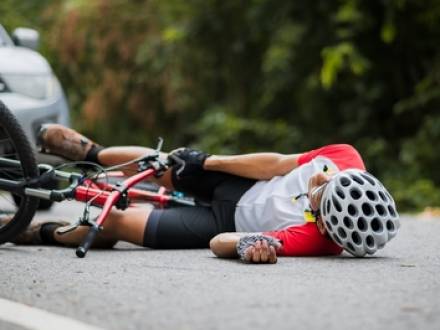What Are the Most Common Injuries in Bicycle Accidents?
 Bicycling is a popular mode of transportation and recreation in Milwaukee and other parts of Wisconsin. However, sharing the road with vehicles can put bicyclists at risk of harm in bicycle accidents, especially when drivers act negligently or fail to share the road safely. When a bicyclist is struck by a vehicle, the injuries can be severe and life-altering. An experienced Wisconsin personal injury attorney can help injured bicyclists address their legal issues and pursue compensation for their injuries.
Bicycling is a popular mode of transportation and recreation in Milwaukee and other parts of Wisconsin. However, sharing the road with vehicles can put bicyclists at risk of harm in bicycle accidents, especially when drivers act negligently or fail to share the road safely. When a bicyclist is struck by a vehicle, the injuries can be severe and life-altering. An experienced Wisconsin personal injury attorney can help injured bicyclists address their legal issues and pursue compensation for their injuries.
Common Injuries in Bicycle Accidents
Bike accidents can result in a wide range of injuries, and an injured bicyclist may require extensive medical treatment and rehabilitation. Here are some of the most common injuries that bicyclists may experience:
-
Head injuries: Even with a helmet, a bicyclist can suffer a concussion due to the impact with a vehicle or the ground. They may even experience more serious traumatic brain injuries (TBIs), which can lead to long-term cognitive impairments, emotional issues, and physical effects.
-
Broken bones: In a collision, bicyclists may extend their arms or legs to brace for impact, leading to broken bones in the forearms, wrists, ankles, or other parts of their limbs. Other types of fractures may also occur, including those affecting the collarbones, ribs, hips, or skull. Depending on the severity of a fracture, extensive treatment, surgery, or implants may be needed, and a person’s mobility and their ability to work or participate in daily activities may be affected.
-
Spinal injuries: The impact of a collision can cause discs in the spine to rupture or shift. Herniated discs can lead to severe pain and mobility issues. In more serious cases, the spinal cord may be damaged or severed, which can lead to partial or total paralysis in different parts of the body.
-
Soft tissue injuries: The impact of a collision may lead to bruises and contusions, and while these injuries may be less severe, they can still be painful, and they may take time to heal. The force of an accident can also cause significant damage to muscles and ligaments, seriously restricting a person’s mobility.
-
Internal injuries: The force of a collision can cause damage to internal organs, which may require emergency medical intervention. Internal bleeding, which can be life-threatening, may not be immediately apparent after an accident, and a person’s life may be placed at risk due to these issues.
Causes of Bicycle Accidents
Bicycle accidents occur for a variety of reasons. Some common causes include:
-
Driver negligence: This may include distracted driving, speeding, and failing to yield the right of way to bicyclists.
-
Road conditions: Poorly maintained roads, potholes, and debris can contribute to accidents, and drivers who fail to account for these conditions may become involved in collisions with bicycles.
-
Weather conditions: Rain, snow, and ice can make roads slippery and reduce visibility, increasing the risk of accidents. Drivers may be responsible for accidents that occur because they failed to reduce their speed or take other safety precautions during inclement weather.
-
Mechanical failures: Faulty brakes, tires, or other components of vehicles can lead to accidents. Drivers may be held responsible for their failure to maintain their vehicles and ensure that they protect the safety of others on the road.
Steps to Take Following a Bicycle Accident
Injured bicyclists can take certain steps to protect their rights and recover financial compensation from negligent drivers or other parties:
-
Seek medical attention: It is important for a cyclist who has been in an accident with a car to receive medical care right away, even if they do not think they are seriously injured. Some injuries may not be immediately apparent. A cyclist should also make sure to follow a doctor's recommendations and attend all follow-up appointments.
-
Document the accident: If possible, an injury victim can take photos of the accident scene, their injuries, and any damage to their bicycle. They can also collect contact information from any witnesses to the accident.
-
Report the accident: Calling 911 after an accident ensures that a police officer will come to the scene and file a police report. This will provide an official record of the accident, and it can play a role in establishing fault.
-
Consult with an attorney: By speaking to an experienced lawyer as soon as possible after an accident, a person can make sure they understand their rights and the steps they can take to recover financial compensation. An attorney can also assist in filing insurance claims, negotiating settlements, and addressing other related concerns.
Contact Our Milwaukee Bicycle Accident Attorneys
The Milwaukee bicycle accident lawyers at Gimbel, Reilly, Guerin & Brown, LLP can provide the legal support needed to ensure that a bicyclist who has been injured by a negligent driver will be properly compensated for their damages. Our experienced attorneys provide compassionate legal help while fighting to protect our clients’ rights and helping them address the serious injuries that they have suffered. Contact us at 414-271-1440 to schedule a consultation and discuss your case.







